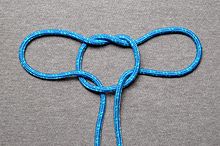


Heraklas (Greek: Ἡρακλᾶς) was a Greek physician of the 1st century AD whose descriptions of surgeons' knots and slings are preserved in book 48 of Oribasius' Medical Collections (Ἰατρικαὶ Συναγωγαί, Iatrikai Synagogai) under the title From Heraklas.[1]
Describing them in detail, Heraklas discussed 16 different knots and slings,[1] including the earliest known written account of a string figure.[2] Accompanying illustrations of the knots were added later by Renaissance copyists, but modern analysis of the writings by knot experts has shown many of these early drawings to contain significant errors or misinterpretations.[3]
- ^ a b Hage, J. Joris (April 2008), "Heraklas on Knots: Sixteen Surgical Nooses and Knots from the First Century A.D.", World Journal of Surgery, vol. 32, no. 4, pp. 648–655, doi:10.1007/s00268-007-9359-x, PMID 18224483
- ^ Miller, Lawrence G. (1945), "The Earliest (?) Description of a String Figure", American Anthropologist, New Series, 47 (3): 461–462, doi:10.1525/aa.1945.47.3.02a00190
- ^ Day, Cyrus L. (1967), Quipus and Witches' Knots, Lawrence: University of Kansas Press, pp. 86–89, 101–151